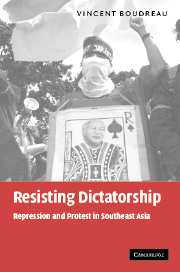Book contents
- Frontmatter
- Contents
- List of maps
- Acknowledgments
- List of abbreviations
- 1 Introduction
- 2 Protest, repression and transition in Southeast Asia
- 3 Authoritarian attack and dictatorial rise
- 4 Protest in socialist Burma
- 5 New Order repression and the Indonesian opposition
- 6 The Philippine new society and state repression
- 7 Repression and protest in comparative perspective
- 8 People power and insurgency in the Philippine transition
- 9 Protest and the underground in Burma
- 10 Indonesia's democracy protests
- 11 Democracy protest and state repression
- List of references
- Index
11 - Democracy protest and state repression
Published online by Cambridge University Press: 15 December 2009
- Frontmatter
- Contents
- List of maps
- Acknowledgments
- List of abbreviations
- 1 Introduction
- 2 Protest, repression and transition in Southeast Asia
- 3 Authoritarian attack and dictatorial rise
- 4 Protest in socialist Burma
- 5 New Order repression and the Indonesian opposition
- 6 The Philippine new society and state repression
- 7 Repression and protest in comparative perspective
- 8 People power and insurgency in the Philippine transition
- 9 Protest and the underground in Burma
- 10 Indonesia's democracy protests
- 11 Democracy protest and state repression
- List of references
- Index
Summary
How do patterns of contention shape transitions to democracy? Many describe protest as essentially an accelerant, pushing state reformers toward making broader concessions than they originally had in mind. Others reduce democracy struggle to almost an epiphenomenon: waters rushing along channels already carved by shifts in regime member interest, by class development and economic growth or some other essentially evolutionary dynamic. Some look to explain regime transitions via alliances between reformers inside the state and moderates in society, as if these identities were significant independent of, and prior to, democracy struggle. Others argue that analysts should write a clearer role for processes of struggle into explanations for these events, often examining how mass-mobilization pressures regime and social elites into democratizing agreements.
Most of these approaches, to my mind, share a central flaw: the process of economic development, changing elite interest or political struggle are judged in terms of how they bring social and political arrangement toward democracy, rather than in how they break down tyranny. Even demonstrating shifts in some elite interests toward democracy falls short of the task, because authoritarian regimes often persist despite the democratic proclivities of some of their members. The real phenomena we should address do not concern the emergence of forces demanding democracy, but the evolution of conditions that undo programs of repression and domination on which dictatorships depend. Any account of democratization processes needs to explain mechanisms that pry open the dictatorship.
- Type
- Chapter
- Information
- Resisting DictatorshipRepression and Protest in Southeast Asia, pp. 238 - 254Publisher: Cambridge University PressPrint publication year: 2004



